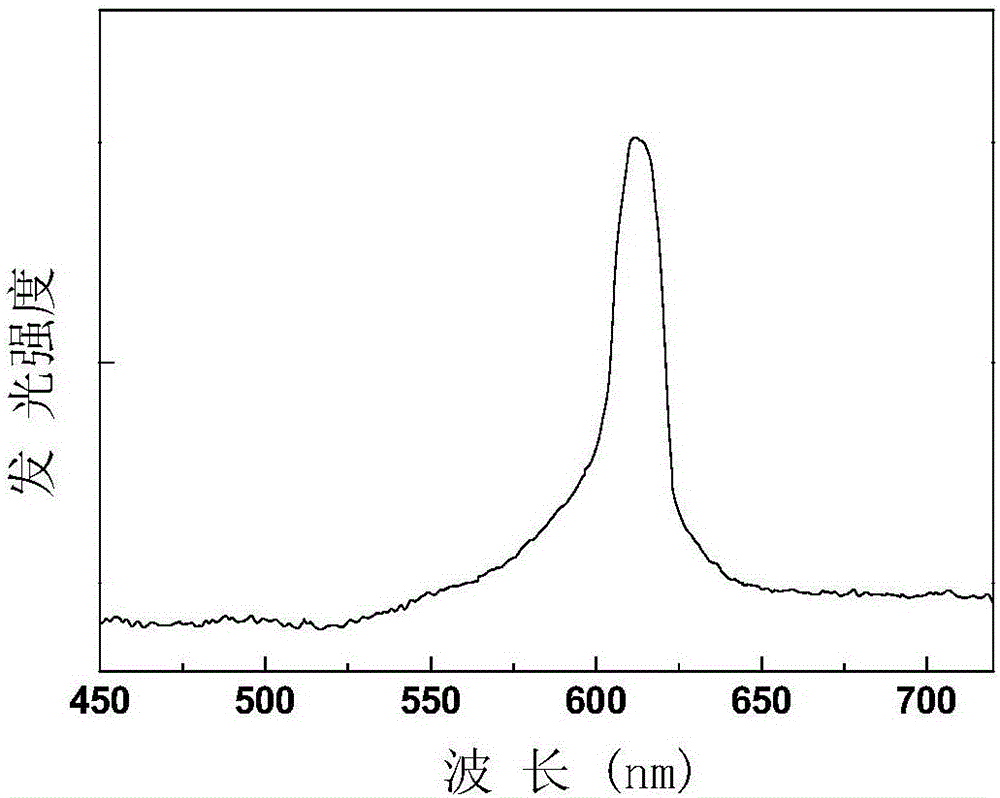Red-light niobium zincate luminescent material, preparation method therefor and application of red-light niobium zincate luminescent material
A technology of luminescent material and zincate, applied in the field of red light niobate zincate luminescent material
- Summary
- Abstract
- Description
- Claims
- Application Information
AI Technical Summary
Problems solved by technology
Method used
Image
Examples
preparation example Construction
[0029] The preparation method of the above-mentioned red light niobium zincate luminescent material comprises the following steps:
[0030] Step S11, according to Me 3-x ZnNb 2 o 9 :xPr 3++ The stoichiometric ratio of each element is weighed, wherein x is 0.01-0.05, y is 0.01-0.08, and Me is at least one selected from calcium element, strontium element and barium element.
[0031] Step S12, organic source selects cyclopentadiene alkaline earth salt (C 5 h 5 ) 2 Me, diethylzinc DEZn, niobium pentaethoxide Nb(OC 2 h 5 ) 5 and tetramethylheptadione praseodymium Pr(DPM) 3 , the molar ratio is (3-x):1:2:x, and the vacuum degree of the chamber is pumped to 1.0×10 with a mechanical pump and a molecular pump -2 Pa~1.0×10 -3Pa, the substrate is heat-treated at 700°C for 10-30 minutes, the rotation speed of the substrate holder is adjusted to 50-1000 rpm, and the carrier gas Ar gas is introduced at a flow rate of 5-15 sccm, and then oxygen is introduced at a flow rate of 10-1...
Embodiment 1
[0045] Example 1: The substrate is ITO glass purchased by CSG, and it is ultrasonically cleaned with toluene, acetone and ethanol for 5 minutes, then rinsed with distilled water, air-dried with nitrogen, and sent to the reaction chamber of the equipment. Use a mechanical pump and a molecular pump to evacuate the chamber to a vacuum of 4.0×10-3Pa; then heat-treat the substrate at 700°C for 20 minutes, and then lower the temperature to 500°C. Turn on the rotating motor, adjust the rotating speed of the substrate holder to 300 rpm, and feed cyclopentadiene calcium (C5H5) 2Ca, diethyl zinc DEZn, pentaethoxide niobium Nb (OC2H5) 5 and tetramethylheptadione praseodymium The carrier gas Ar gas of Pr(DPM)3 has a flow rate of 10 sccm. Oxygen gas was introduced with a flow rate of 120 sccm to start the deposition of the film. The thickness of the film is deposited to 150nm, close the organic source and carrier gas, continue to pass oxygen, the temperature drops below 100°C, and take ou...
Embodiment 2
[0046] Example 2: The substrate is ITO glass purchased by CSG, which is ultrasonically cleaned with toluene, acetone and ethanol for 5 minutes, then rinsed with distilled water, air-dried with nitrogen, and sent to the reaction chamber of the equipment. Use a mechanical pump and a molecular pump to evacuate the chamber to a vacuum of 1.0×10-3Pa; then heat-treat the substrate at 700°C for 10 minutes, and then lower the temperature to 250°C. Turn on the rotating motor, adjust the rotating speed of the substrate holder to 50 rpm, and feed cyclopentadiene calcium (C5H5) 2Ca, diethyl zinc DEZn, pentaethoxide niobium Nb (OC2H5) 5 and tetramethylheptadione praseodymium The carrier gas Ar gas of Pr(DPM) 3 is fed with oxygen, and the flow rate is 10 sccm, and the deposition of the thin film is started. The thickness of the film is deposited to 80nm, close the organic source and carrier gas, continue to pass oxygen, the temperature drops below 100°C, and take out the sample Ca2.92ZnNb2O...
PUM
| Property | Measurement | Unit |
|---|---|---|
| thickness | aaaaa | aaaaa |
| thickness | aaaaa | aaaaa |
Abstract
Description
Claims
Application Information
 Login to View More
Login to View More - R&D
- Intellectual Property
- Life Sciences
- Materials
- Tech Scout
- Unparalleled Data Quality
- Higher Quality Content
- 60% Fewer Hallucinations
Browse by: Latest US Patents, China's latest patents, Technical Efficacy Thesaurus, Application Domain, Technology Topic, Popular Technical Reports.
© 2025 PatSnap. All rights reserved.Legal|Privacy policy|Modern Slavery Act Transparency Statement|Sitemap|About US| Contact US: help@patsnap.com


